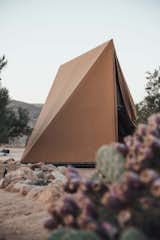[ad_1]
Glamping comes in many shapes and sizes, but you know it when you see it: a structure or series of structures arranged in a pristine slice of wilderness or natural-looking plot, with more amenities than you’d get with an accommodation that can be stuffed into a small bag, but far fewer than a hotel. The accommodations might be an Airstream, an A-frame cabin, or something resembling a tent. Or, something combining an A-frame with a tent, as is the case with Nokken and Bjarke Ingels Group’s new collaboration.
The Softshell is a 387-square-foot cabin with canvas panels wrapping an angular, A-frame-inspired frame. “Over the last fifteen or twenty years, the marketplace has been dominated by bell tents or yurts,” says Nokken cofounder Nathan Aylott. “They’re very traditional forms. They’ve almost become the default option if you’re setting up a glamping site.”
In Aylott’s telling, the Softshell’s severe shape sets it apart just enough from another canvas tent. “Suddenly this quite large, quite angular element has come along. Of course, it’s not a million miles away from a typical tent that you’d use every weekend, but it’s different enough. And I think that’s the point.”
But the point is also that it’s designed to be easily transported and built. Hoteliers, hospitality groups, or individuals could add the semipermanent structures to a property with a relatively light lift. The units ship in four large crates, meaning that, in theory, they could be set up in places where traditional construction would be too challenging or costly. Aylott estimates that two people could set up the tent over the course of hours, a process primarily involving joining precut ends and sleeving them into metal bolts.
Aylott says Nokken started thinking about a glamping structure after the pandemic, as there seemed to be a move away from classic luxury hotels and toward nature-driven, experience-based travel. A few years earlier, Bjarke Ingels Group (BIG) had explored the glamping market with the Klein Cabin, a 183-square-foot prefab prototype. It never went into production, but ended up serving as a precursor to the Softshell, with the tent borrowing from the cabin’s angular, A-framesque silhouette.
BIG is no stranger to experimentation, of course: the firm is developing a 3D-printed property in Marfa, Texas, created the world’s only hybrid ski facility and power plant, and a constructed a bridge that spirals over a river in Norway.
Nokken, which is known for making svelte prefabricated cabins, started with a prefab design for the Softshell. A timber frame system supports a canvas outer made from a cotton-polyester blend that can comes in a range of colors including khaki, dark green, or navy. The plan includes a kitchenette, bathroom, window, and sitting area, and the tent’s sharply pitched roof makes room for a mezzanine made from netting, accessed by a ladder.
Whereas Nokken’s cabins are designed with some furnishings and built-ins, the tents are blank slates inside. “We made it non-brand specific because we’re a hardware company. We make items for operators, hotels, and land owners to adopt and pivot to match their own brand,” explains Aylott. That would allow a hospitality operation to add its own touches, continues Aylott, “whether that be through the landscape itself or the different colorways and fixtures.
A standard unit, which includes a hammock with a ladder and a bedhead, is currently being offered at $22,500 via the company’s website. For an additional fee, customers can add on a deck extension, acoustic installation, an indoor or outdoor kitchen, and a bed. Aylott says the company is working on adding even more optional features, which would include a woodburning stove, thermal insulation for severe climates, and a built-out loft with an en suite bathroom below. After all, amenities like these are what put the “glamour” in glamping.
More from Nokken:
These Tiny Prefab Cabins Are Designed to Feel Like Luxe Hotel Rooms
[ad_2]





